
womeninspaceexploration
32 posts
Latest Posts by womeninspaceexploration


Microgravity
NASA ID: 9515855
Date Created: 1995-10-20
Onboard STS-73, USML-2: Mission Specialist, Payload Commander, Kathryn Thorton with (CGF) Crystal Growth Furnace
Witch Head Nebula
Image Credit: NASA/STScI Digitized Sky Survey/Noel Carboni
As the name implies, this reflection nebula associated with the star Rigel looks suspiciously like a fairytale crone. Formally known as IC 2118 in the constellation Orion, the Witch Head Nebula glows primarily by light reflected from the star. The color of this very blue nebula is caused not only by blue color of its star, but also because the dust grains reflect blue light more efficiently than red. A similar physical process causes Earth's daytime sky to appear blue.
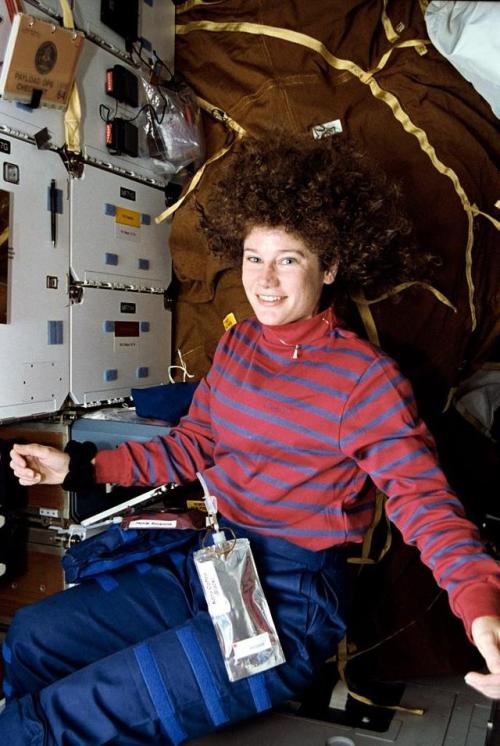
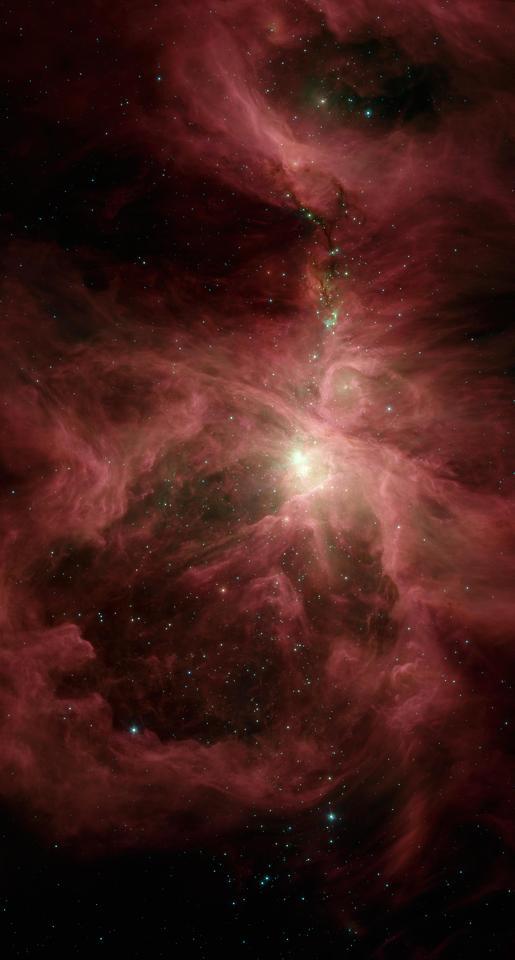
The Sword of Orion
NASA ID: PIA08653
Date Created: 2006-08-15
This image from NASA Spitzer Space Telescope shows the Orion nebula, our closest massive star-making factory, 1,450 light-years from Earth. The nebula is close enough to appear to the naked eye as a fuzzy star in the sword of the constellation.
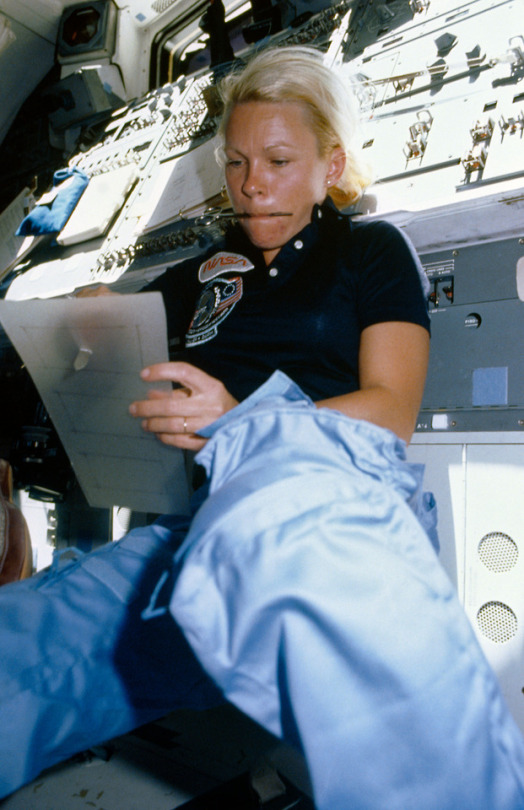
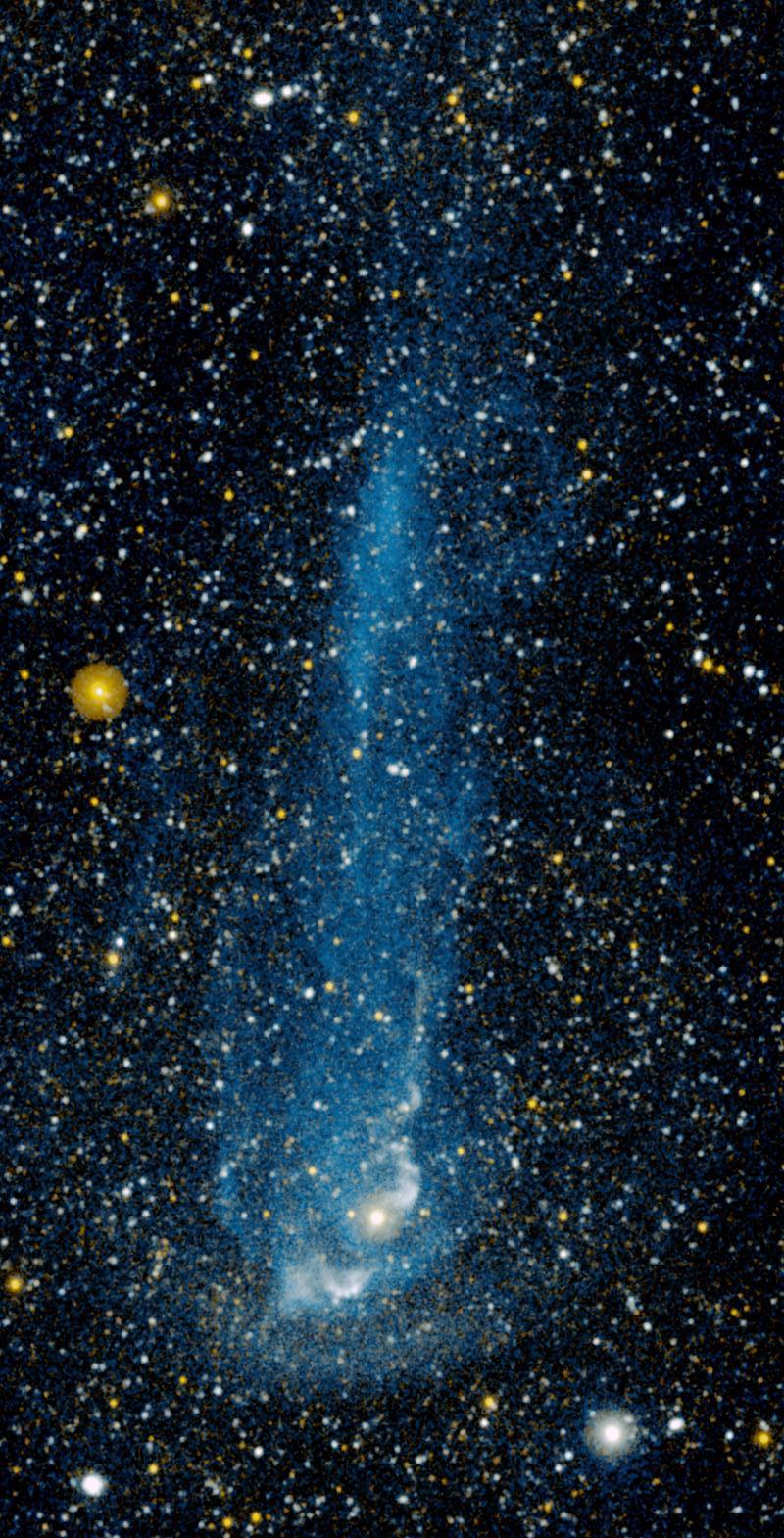
Astronaut Rhea Seddon works on flyswatter-like snagging device
NASA ID: 51d-07-003
Date Created: 1985-04-17
51D-07-003 (12-19 April 1985) --- Astronaut Rhea Seddon begins early work on a fly swatter-like snagging device to be used as an extension to the Remote Manipulator System (RMS) arm on Discovery for an April 17, 1985 attempt to trip a lever on the troubled Syncom-IV satellite.
Anatomy of a Shooting Star
NASA ID: PIA09959
Date Created: 2007-08-15
A close-up view of a star racing through space faster than a speeding bullet can be seen in this image from NASA Galaxy Evolution Explorer. The star is called Mira pronounced My-rah.
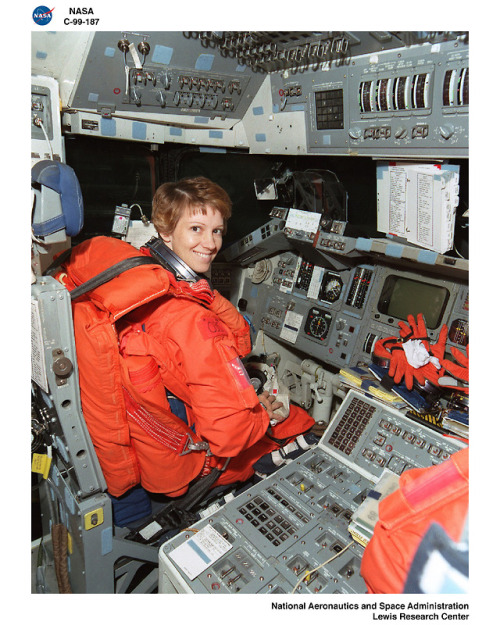
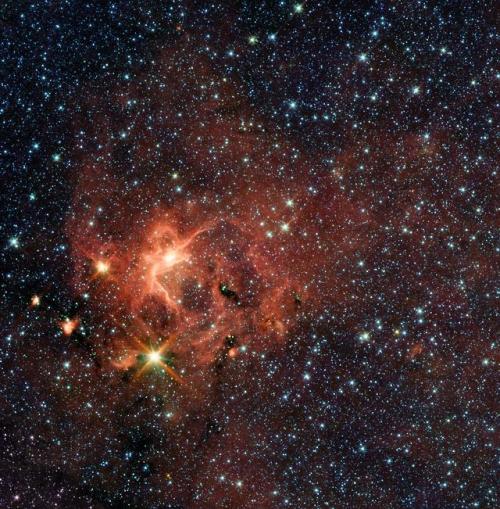
Massive Young Star and its Cradle
NASA ID: PIA13276
Date Created: 2010-07-14
This star-forming region, captured by NASA Spitzer Space Telescope, is dominated by the bright, young star IRAS 13481-6124; it is the first massive baby star for which astronomers could obtain a detailed look at the dusty disk closely encircling it.
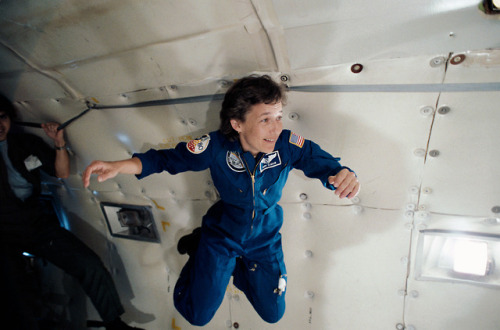
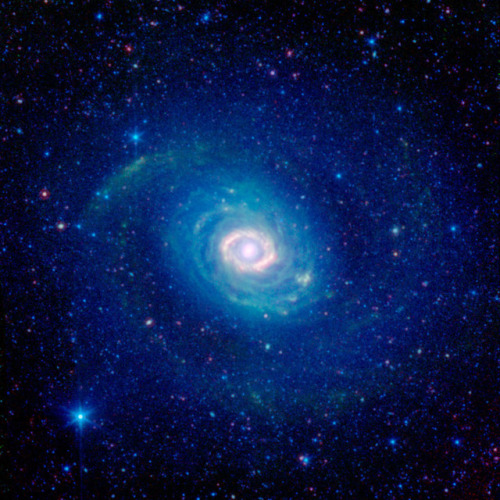
STS 61-B crewmembers training on the KC-135 in zero-G
NASA ID: S85-39137
Date Created: 1985-08-21
STS 61-B crewmembers training on the KC-135 in zero-G. Views include Payload specialist Charles D. Walker attempting to down the lower torso of his extravehicular mobility unit (EMU) in zero-G in the KC-135. He is being assisted by other participants in the training (39135); Payload specialist Rodolfo Neri floating in midair during training in the KC-135 (39136,39138); Mission specialist Mary L. Cleave floating in midair during her training aboard the KC-135 (39137); Astronaut Bryan D. O'Connor assists Astronaut Sherwood C. Spring in completing his donning of the EMU in the KC-135 (39139); Technicians aid Spring with his EMU in the KC-135 (39140); O'Connor appears to be leaping up in zero-G aboard the KC-135 (39141); Astronaut Brewster Shaw is assisted by a technician to don his EMU (39142); Shaw is attempting to don the EMU gloves while O'Connor watches (39143); Shaw does jumping jacks while Neri attempts to travel down a rope guideline (39144).
Galactic Wheels within Wheels
Mission: Spitzer Space Telescope
Instrument: Infrared Array Camera (IRAC)
Image credit: NASA/JPL-Caltech
MAY 16, 2013
How many rings do you see in this new image of the galaxy Messier 94, also known as NGC 4736? While at first glance one might see a number of them, astronomers believe there is just one. This image was captured in infrared light by NASA's Spitzer Space Telescope.
Historically, Messier 94 was considered to have two strikingly different rings: a brilliant, compact band encircling the galaxy's core, and a faint, broad, swath of stars falling outside its main disk.
Astronomers have recently discovered that the outer ring, seen here in the deep blue glow of starlight, might actually be more of an optical illusion. A 2009 study combined infrared Spitzer observations with those from other telescopes, including ultraviolet data from NASA's Galaxy Evolution Explorer, now operated by the California Institute of Technology, Pasadena; visible data from the Sloan Digital Sky Survey; and shorter-wavelength infrared light from the Two Micron All Sky Survey (2MASS). This more complete picture of Messier 94 indicates that we are really seeing two separate spiral arms, which, from our perspective, take on the appearance of a single, unbroken ring.
The bright inner ring of Messier 94 is very real, however. This area is sometimes identified as a "starburst ring" because of the frenetic pace of star formation in the confined area. Starbursts like this can often be triggered by gravitational encounters with other galaxies, but in this case might be caused by the galaxy's oval shape.
Tucked in between the inner starburst ring and the outer ring-like arms is the galaxy's disk, striated with greenish filaments of dust. While these dusty arcs look like a collection of rings, they actually follow tightly wound spiral arcs.
Infrared light with wavelengths of 3.6 and 4.5 microns is represented in blue/cyan, and primarily shows the glow from starlight. Light of 8 microns is rendered in green, and 24-micron emission is red, tracing the cooler and warmer components of dust, respectively. The image was taken in 2004, before Spitzer ran out of cryogen.
The 2MASS mission was a joint effort between the California Institute of Technology, Pasadena, Calif., the University of Massachusetts and NASA's Jet Propulsion Laboratory, Pasadena, Calif.
NASA's Jet Propulsion Laboratory, Pasadena, Calif., manages the Spitzer Space Telescope mission for NASA's Science Mission Directorate, Washington. Science operations are conducted at the Spitzer Science Center at the California Institute of Technology in Pasadena. Data are archived at the Infrared Science Archive housed at the Infrared Processing and Analysis Center at Caltech. Caltech manages JPL for NASA. For more information about Spitzer, visit http://spitzer.caltech.edu and http://www.nasa.gov/spitzer.


Candid view of a crewmember playing a flute in the aft flight deck.
NASA ID: sts056-29-019
Date Created: 1993-04-17
STS056-29-019 (8-17 April 1993) --- Astronaut Ellen Ochoa, STS-56 mission specialist, takes a brief time out from a busy day in space to play a 15-minute set of flute offerings on the space shuttle Discovery's aft flight deck. Ochoa, who has played the flute for 25 years, performed the Marine Corps Hymn, Navy Hymn and God Save the Queen for fellow crew members as well as some Vivaldi for herself. Photo credit: NASA
NGC 6960: The Witch's Broom Nebula Image Credit & Copyright: Martin Pugh (Heaven's Mirror Observatory)
Ten thousand years ago, before the dawn of recorded human history, a new light would have suddenly have appeared in the night sky and faded after a few weeks. Today we know this light was from a supernova, or exploding star, and record the expanding debris cloud as the Veil Nebula, a supernova remnant. This sharp telescopic view is centered on a western segment of the Veil Nebula cataloged as NGC 6960 but less formally known as the Witch's Broom Nebula. Blasted out in the cataclysmic explosion, the interstellar shock wave plows through space sweeping up and exciting interstellar material. Imaged with narrow band filters, the glowing filaments are like long ripples in a sheet seen almost edge on, remarkably well separated into atomic hydrogen (red) and oxygen (blue-green) gas. The complete supernova remnant lies about 1400 light-years away towards the constellation Cygnus. This Witch's Broom actually spans about 35 light-years. The bright star in the frame is 52 Cygni, visible with the unaided eye from a dark location but unrelated to the ancient supernova remnant.
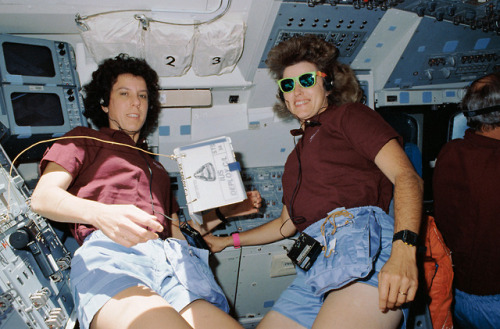
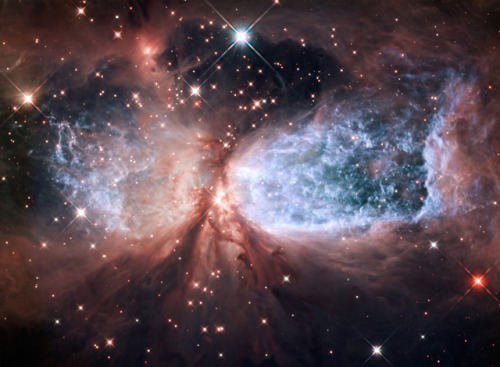
STS-34 crew members during Galileo pre-deployment exercises on flight deck
NASA ID: s34-09-007
Date Created: 1989-10-18
STS034-09-007 (23 Oct. 1989) --- Having been in space only a few hours, three of the STS-34 astronaut crew prepare for pre-deployment exercises involving one of the most prominent "passengers" of the flight -- the Galileo payload which was lying in Atlantis', Orbiter Vehicle (OV) 104's, payload bay (PLB). Pictured, left to right, are astronauts Ellen S. Baker and Shannon W. Lucid, both mission specialists; along with Donald E. Williams, commander, who guided OV-104's course during the exercise. Baker and Lucid communicated with ground controllers while juggling other Galileo-related chores. Both Baker and Lucid are equipped with SONY Walkmans and are wearing headsets. Lucid wears a pair of sunglasses with brightly colored frames. A tethered inertial upper stage (IUS) deploy checklist (C/L) floats between the two and a spot meter is Velcroed to an on orbit station control panel.
Hubble Serves Up a Holiday Snow Angel
NASA ID: GSFC_20171208_Archive_e001800
Date Created: 12/8/2017
The bipolar star-forming region, called Sharpless 2-106, looks like a soaring, celestial snow angel. The outstretched “wings” of the nebula record the contrasting imprint of heat and motion against the backdrop of a colder medium. Twin lobes of super-hot gas, glowing blue in this image, stretch outward from the central star. This hot gas creates the “wings” of our angel. A ring of dust and gas orbiting the star acts like a belt, cinching the expanding nebula into an “hourglass” shape. To read more about this image go to: <a href="http://www.nasa.gov/mission_pages/hubble/science/snow-angel.html" rel="nofollow">www.nasa.gov/mission_pages/hubble/science/snow-angel.html</a> Credit: NASA, ESA, and the Hubble Heritage Team (STScI/AURA) <b><a href="http://www.nasa.gov/audience/formedia/features/MP_Photo_Guidelines.html" rel="nofollow">NASA image use policy.</a></b> <b><a href="http://www.nasa.gov/centers/goddard/home/index.html" rel="nofollow">NASA Goddard Space Flight Center</a></b> enables NASA’s mission through four scientific endeavors: Earth Science, Heliophysics, Solar System Exploration, and Astrophysics. Goddard plays a leading role in NASA’s accomplishments by contributing compelling scientific knowledge to advance the Agency’s mission.
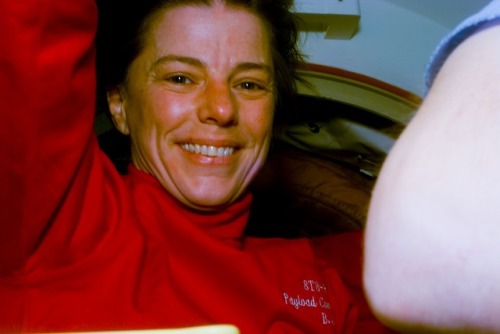
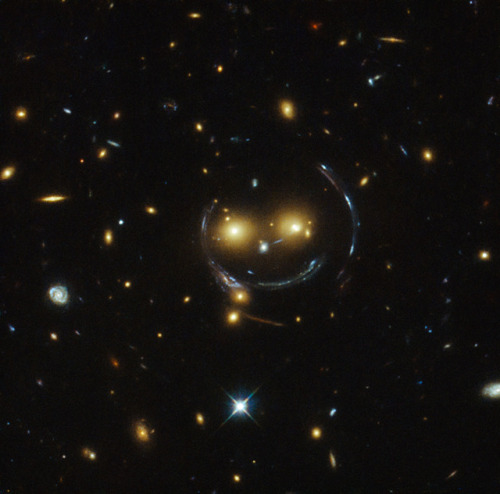
Scenes from the STS-89/Mir 24 welcome ceremony
NASA ID: s89e5175
Date Created: 1998-03-04
S89-E-5175 (24 Jan 1998) --- This Electronic Still Camera (ESC) image shows astronaut Bonnie J. Dunbar, payload commander, shortly after Shuttle/Mir docking activities began. "Deja-vu" may have come to the mind of Dunbar as she boarded Russia's Mir Space Station. Dunbar was a member of the STS-71 crew -- the first United States aggregation to visit Mir -- along with cosmonaut Anatoliy Y. Solovyev, Mir-24 commander. The ESC view was taken at 22:37:23 GMT, on January 24, 1998.
Hubble Sees A Smiling Lens
NASA ID: GSFC_20171208_Archive_e000791
Date Created: 12/8/2017
In the center of this image, taken with the NASA/ESA Hubble Space Telescope, is the galaxy cluster SDSS J1038+4849 — and it seems to be smiling. You can make out its two orange eyes and white button nose. In the case of this “happy face”, the two eyes are very bright galaxies and the misleading smile lines are actually arcs caused by an effect known as strong gravitational lensing. Galaxy clusters are the most massive structures in the Universe and exert such a powerful gravitational pull that they warp the spacetime around them and act as cosmic lenses which can magnify, distort and bend the light behind them. This phenomenon, crucial to many of Hubble’s discoveries, can be explained by Einstein’s theory of general relativity. In this special case of gravitational lensing, a ring — known as an Einstein Ring — is produced from this bending of light, a consequence of the exact and symmetrical alignment of the source, lens and observer and resulting in the ring-like structure we see here. Hubble has provided astronomers with the tools to probe these massive galaxies and model their lensing effects, allowing us to peer further into the early Universe than ever before. This object was studied by Hubble’s Wide Field and Planetary Camera 2 (WFPC2) and Wide Field Camera 3 (WFC3) as part of a survey of strong lenses. A version of this image was entered into the Hubble’s Hidden Treasures image processing competition by contestant Judy Schmidt. Image Credit: NASA/ESA
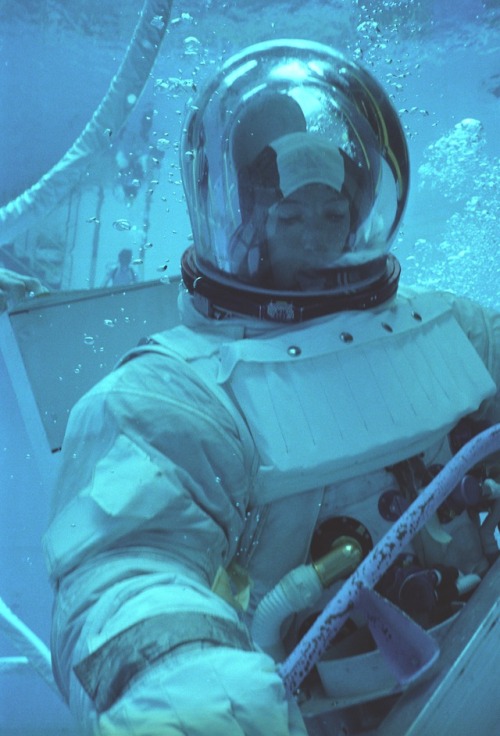
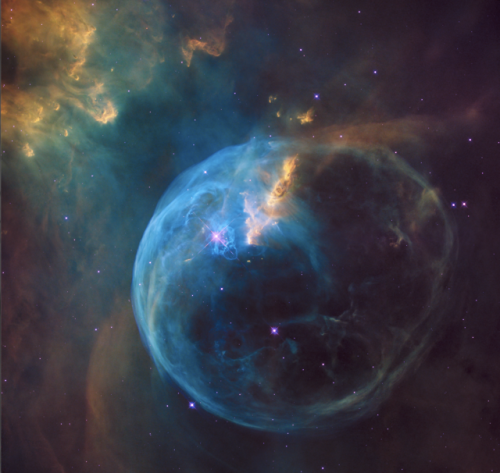
History of Hubble Space Telescope (HST)
NASA ID: 8004550
Date Created: 1980-05-08
The Hubble Space Telescope (HST) is a cooperative program of the European Space Agency (ESA) and the National Aeronautical and Space Administration (NASA) to operate a long-lived space-based observatory. It was the flagship mission of NASA's Great Observatories program. The HST program began as an astronomical dream in the 1940s. During the 1970s and 1980s, the HST was finally designed and built becoming operational in the 1990s. The HST was deployed into a low-Earth orbit on April 25, 1990 from the cargo bay of the Space Shuttle Discovery (STS-31). The design of the HST took into consideration its length of service and the necessity of repairs and equipment replacement by making the body modular. In doing so, subsequent shuttle missions could recover the HST, replace faulty or obsolete parts and be re-released. Marshall Space Flight Center’s (MSFC's) Neutral Buoyancy Simulator (NBS) served as the test center for shuttle astronauts training for Hubble related missions. Shown is astronaut Anna Fisher training on a mock-up of a modular section of the HST for an axial scientific instrument change out.
Hubble Sees a Star ‘Inflating’ a Giant Bubble
NASA ID: GSFC_20171208_Archive_e000383
Date Created: 12/8/2017
For the 26th birthday of NASA’s Hubble Space Telescope, astronomers are highlighting a Hubble image of an enormous bubble being blown into space by a super-hot, massive star. The Hubble image of the Bubble Nebula, or NGC 7635, was chosen to mark the 26th anniversary of the launch of Hubble into Earth orbit by the STS-31 space shuttle crew on April 24, 1990 “As Hubble makes its 26th revolution around our home star, the sun, we celebrate the event with a spectacular image of a dynamic and exciting interaction of a young star with its environment. The view of the Bubble Nebula, crafted from WFC-3 images, reminds us that Hubble gives us a front row seat to the awe inspiring universe we live in,” said John Grunsfeld, Hubble astronaut and associate administrator of NASA’s Science Mission Directorate at NASA Headquarters, in Washington, D.C. The Bubble Nebula is seven light-years across—about one-and-a-half times the distance from our sun to its nearest stellar neighbor, Alpha Centauri, and resides 7,100 light-years from Earth in the constellation Cassiopeia. The seething star forming this nebula is 45 times more massive than our sun. Gas on the star gets so hot that it escapes away into space as a “stellar wind” moving at over four million miles per hour. This outflow sweeps up the cold, interstellar gas in front of it, forming the outer edge of the bubble much like a snowplow piles up snow in front of it as it moves forward. As the surface of the bubble's shell expands outward, it slams into dense regions of cold gas on one side of the bubble. This asymmetry makes the star appear dramatically off-center from the bubble, with its location in the 10 o’clock position in the Hubble view. Dense pillars of cool hydrogen gas laced with dust appear at the upper left of the picture, and more “fingers” can be seen nearly face-on, behind the translucent bubble. The gases heated to varying temperatures emit different colors: oxygen is hot enough to emit blue light in the bubble near the star, while the cooler pillars are yellow from the combined light of hydrogen and nitrogen. The pillars are similar to the iconic columns in the “Pillars of Creation” Eagle Nebula. As seen with the structures in the Eagle Nebula, the Bubble Nebula pillars are being illuminated by the strong ultraviolet radiation from the brilliant star inside the bubble. The Bubble Nebula was discovered in 1787 by William Herschel, a prominent British astronomer. It is being formed by a proto-typical Wolf-Rayet star, BD +60º2522, an extremely bright, massive, and short-lived star that has lost most of its outer hydrogen and is now fusing helium into heavier elements. The star is about four million years old, and in 10 million to 20 million years, it will likely detonate as a supernova. Hubble’s Wide Field Camera-3 imaged the nebula in visible light with unprecedented clarity in February 2016. The colors correspond to blue for oxygen, green for hydrogen, and red for nitrogen. This information will help astronomers understand the geometry and dynamics of this complex system. The Bubble Nebula is one of only a handful of astronomical objects that have been observed with several different instruments onboard Hubble. Hubble also imaged it with the Wide Field Planetary Camera (WFPC) in September 1992, and with Wide Field Planetary Camera-2 (WFPC2) in April 1999. The Hubble Space Telescope is a project of international cooperation between NASA and the European Space Agency. NASA's Goddard Space Flight Center in Greenbelt, Maryland, manages the telescope. The Space Telescope Science Institute (STScI) in Baltimore, Maryland, conducts Hubble science operations. STScI is operated for NASA by the Association of Universities for Research in Astronomy in Washington, D.C. Credit: NASA, ESA, and the Hubble Heritage Team (STScI/AURA)

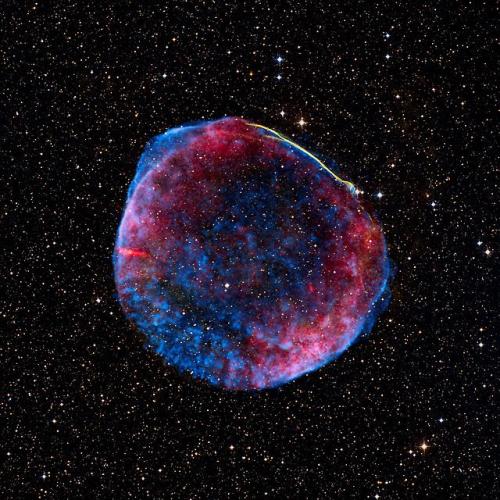
Sally K. Ride
Title: Sally K. Ride
Catalog #: WOF_00203
Additional Information: Astronaut
Item Location: Women of Flight Box 3
Collection: Women of Flight Special Collection
Tags: Women of Flight Photo, Sally K. Ride
Repository: San Diego Air and Space Museum Archive
Hubble Sees Stars and a Stripe in Celestial Fireworks
Creator: NASA Goddard
Date Created: 12/8/2017
NASA ID: GSFC_20171208_Archive_e002166
Release date: July 1, 2008 This image is a composite of visible (or optical), radio, and X-ray data of the full shell of the supernova remnant from SN 1006. The radio data show much of the extent that the X-ray image shows. In contrast, only a small linear filament in the northwest corner of the shell is visible in the optical data. The object has an angular size of roughly 30 arcminutes (0.5 degree, or about the size of the full moon), and a physical size of 60 light-years (18 parsecs) based on its distance of nearly 7,000 light-years. The small green box along the bright filament at the top of the image corresponds to the dimensions of the Hubble release image. The optical data was obtained at the University of Michigan's 0.9-meter Curtis Schmidt telescope at the National Science Foundation's Cerro Tololo Inter-American Observatory (CTIO) near La Serena, Chile. H-alpha, continuum-subtracted data were provided by F. Winkler (Middlebury COllege) et al. The X-ray data were acquired from the Chandra X-ray Observatory's AXAF CCD Imaging Spectrometer (ACIS) at 0.5-3keV, and were provided by J. Hughes (Rutgers University) et al. The radio data, supplied by K. Dyer (NRAO, Socorro) et al., were a composite from the National Radio Astronomy Observatory's Very Large Array (NRAO/VLA) in Socorro, New Mexico, along with the Green Bank Telescope (GBT) in Green Bank, West Virginia. Data of the supernova remnant were blended on a visible-light stellar background created using the Digitized Sky Survey's Anglo-Australian Observatory (AAO2) blue and red plates. Photo Credit: NASA, ESA, and Z. Levay (STScI) Science Credit: Radio: NRAO/AUI/NSF GBT+VLA 1.4 GHz mosaic (Dyer, Maddalena and Cornwell, NRAO); X-ray: NASA/CXC/Rutgers/G. Cassam-Chenai and J. Hughes et al.; Optical: F.Winkler/Middlebury College and NOAO/AURA/NSF; and DSS



Chawla prepares the CM for installation of MIST in the SH during STS-107
STS-107 Mission Specialist 2 MS Kalpana 'KC' Chawla reads a checklist in the Spacehab SH Research Double Module RDM as she prepares the Combustion Module CM-2 for installation of the Water Mist Fire Suppression Experiment MIST.
Kalpana Chawla
(March 17, 1962 – February 1, 2003) was an American astronaut, engineer, and the first female of Indian origin to go to space. She first flew on Space Shuttle Columbia in 1997 as a mission specialist and primary robotic arm operator. In 2003, Chawla was one of the seven crew members who died in the Space Shuttle Columbia disaster when the spacecraft disintegrated during its re-entry into the Earth's atmosphere. Chawla was posthumously awarded the Congressional Space Medal of Honor, and several streets, universities and institutions have been named in her honor.
Hubble Looks Into a Cosmic Kaleidoscope
At first glance, this cosmic kaleidoscope of purple, blue and pink offers a strikingly beautiful — and serene — snapshot of the cosmos. However, this multi-colored haze actually marks the site of two colliding galaxy clusters, forming a single object known as MACS J0416.1-2403 (or MACS J0416 for short).
MACS J0416 is located about 4.3 billion light-years from Earth, in the constellation of Eridanus. This image of the cluster combines data from three different telescopes: the NASA/ESA Hubble Space Telescope (showing the galaxies and stars), the NASA Chandra X-ray Observatory (diffuse emission in blue), and the NRAO Jansky Very Large Array (diffuse emission in pink). Each telescope shows a different element of the cluster, allowing astronomers to study MACS J0416 in detail.
As with all galaxy clusters, MACS J0416 contains a significant amount of dark matter, which leaves a detectable imprint in visible light by distorting the images of background galaxies. In this image, this dark matter appears to align well with the blue-hued hot gas, suggesting that the two clusters have not yet collided; if the clusters had already smashed into one another, the dark matter and gas would have separated. MACS J0416 also contains other features — such as a compact core of hot gas — that would likely have been disrupted had a collision already occurred.
Together with five other galaxy clusters, MACS J0416 is playing a leading role in the Hubble Frontier Fields program, for which this data was obtained. Owing to its huge mass, the cluster is in fact bending the light of background objects, acting as a magnifying lens. Astronomers can use this phenomenon to find galaxies that existed only hundreds of million years after the big bang.
For more information on both Frontier Fields and the phenomenon of gravitational lensing, see Hubblecast 90: The final frontier.
Text credit: European Space Agency Image credit: NASA, ESA, CXC, NRAO/AUI/NSF, STScI, and G. Ogrean (Stanford University), Acknowledgment: NASA, ESA, and J. Lotz (STScI), and the HFF team

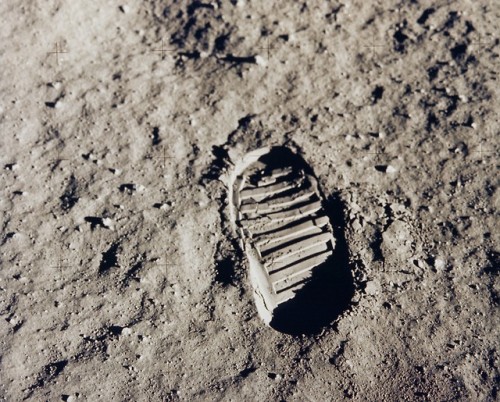
Hamilton in 1969, standing next to listings of the software she and her MIT team produced for the Apollo project.
The very first contract NASA issued for the Apollo program (in August 1961) was with the Massachusetts Institute of Technology to develop the guidance and navigation system for the Apollo spacecraft. Hamilton, a computer programmer, would wind up leading the Software Engineering Division of the MIT Instrumentation Laboratory (now Draper Labs). Computer science, as we now know it, was just coming into existence at the time. Hamilton led the team that developed the building blocks of software engineering – a term that she coined herself. Her systems approach to the Apollo software development and insistence on rigorous testing was critical to the success of Apollo. As she noted, “There was no second chance. We all knew that.” Her approach proved itself on July 20, 1969, when minutes before Armstrong and Aldrin landed on the Moon, the software overrode a command to switch the flight computer’s priority system to a radar system. The override was announced by a “1202 alarm” which let everyone know that the guidance computer was shedding less important tasks (like rendezvous radar) to focus on steering the descent engine and providing landing information to the crew. Armstrong and Aldrin landed on the Moon, rather than aborting the approach due to computer problems. In fact, the Apollo guidance software was so robust that no software bugs were found on any crewed Apollo missions, and it was adapted for use in Skylab, the Space Shuttle, and the first digital fly-by-wire systems in aircraft. Hamilton was honored by NASA in 2003, when she was presented a special award recognizing the value of her innovations in the Apollo software development. The award included the largest financial award that NASA had ever presented to any individual up to that point.
First Footprints On Another World
One of the first steps taken on the Moon, this is an image of Buzz Aldrin's bootprint from the Apollo 11 mission. Neil Armstrong and Buzz Aldrin walked on the Moon on July 20, 1969. The Apollo 11 mission launched on July 16 on a Saturn V launch vehicle developed by NASA’s Marshall Space Flight Center in Huntsville, Alabama.
Image credit: NASA


NASA’s Hidden Figure
NASA research mathematician Katherine Johnson is photographed at work at NASA Langley Research Center in 1980.
Johnson began her career in 1953 at the National Advisory Committee for Aeronautics (NACA), the agency that preceded NASA, one of a number of African-American women hired to work as "computers" in what was then their Guidance and Navigation Department, just as the NACA was beginning its work on space. Johnson became known for her training in geometry, her leadership, and her inquisitive nature; she was the only woman at the time to be pulled from the computing pool to work with engineers on other programs. Katherine Johnson spent more than three decades as a mathematician at NASA and the NACA.
Johnson worked at Langley from 1953 until her retirement in 1986, making critical technical contributions which included calculating the trajectory of the 1961 flight of Alan Shepard, the first American in space. "The early trajectory was a parabola, and it was easy to predict where it would be at any point," Johnson said. "Early on, when they said they wanted the capsule to come down at a certain place, they were trying to compute when it should start. I said, 'Let me do it. You tell me when you want it and where you want it to land, and I'll do it backwards and tell you when to take off.' That was my forte."
Johnson is also known for verifying the calculations made by electronic computers of John Glenn’s 1962 launch to orbit and the 1969 Apollo 11 trajectory to the moon. She also worked on the space shuttle program and the Earth Resources Satellite and encouraged students to pursue careers in science and technology. She was awarded the Presidential Medal of Freedom, the nation's highest civilian honor, by President Barack Obama on Nov. 24, 2015.
Image Credit: NASA
Read more about the hidden figures of NASA here
Hubble’s Hidden Galaxy
C 342 is a challenging cosmic target. Although it is bright, the galaxy sits near the equator of the Milky Way’s galactic disk, where the sky is thick with glowing cosmic gas, bright stars, and dark, obscuring dust. In order for astronomers to see the intricate spiral structure of IC 342, they must gaze through a large amount of material contained within our own galaxy — no easy feat! As a result IC 342 is relatively difficult to spot and image, giving rise to its intriguing nickname: the “Hidden Galaxy.”
Located very close (in astronomical terms) to the Milky Way, this sweeping spiral galaxy would be among the brightest in the sky were it not for its dust-obscured location. The galaxy is very active, as indicated by the range of colors visible in this NASA/ESA Hubble Space Telescope image, depicting the very central region of the galaxy. A beautiful mixture of hot, blue star-forming regions, redder, cooler regions of gas, and dark lanes of opaque dust can be seen, all swirling together around a bright core. In 2003, astronomers confirmed this core to be a specific type of central region known as an HII nucleus — a name that indicates the presence of ionized hydrogen — that is likely to be creating many hot new stars.
Image credit: ESA/Hubble & NASA
Text credit: European Space Agency
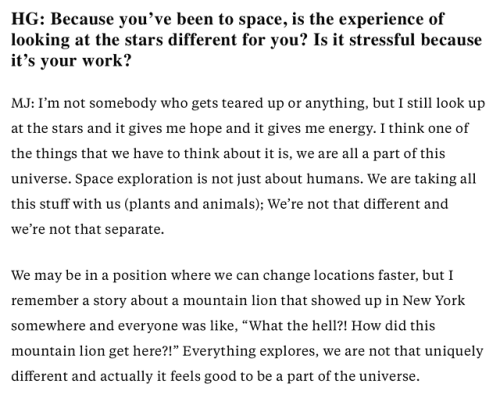
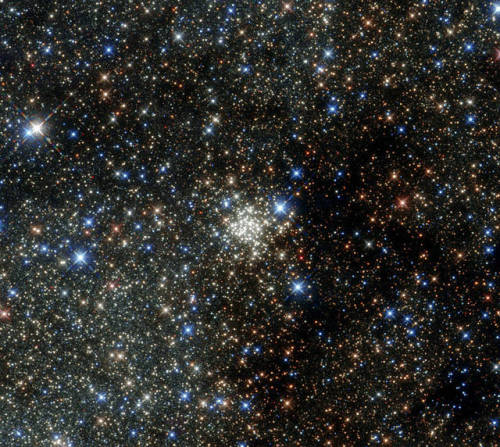
Interview with Mae Jemison
https://hellogiggles.com/news/first-african-american-woman-astronaut-mae-jemison-talks-to-us-about-going-to-mars/
Arches Cluster
This NASA/ESA Hubble Space Telescope image presents the Arches Cluster, the densest known star cluster in the Milky Way. It is located about 25,000 light-years from Earth in the constellation of Sagittarius (The Archer), close to the heart of our galaxy, the Milky Way. It is, like its neighbor the Quintuplet Cluster, a fairly young astronomical object at between two and four million years old.
The Arches cluster is so dense that in a region with a radius equal to the distance between the sun and its nearest star there would be over 100,000 stars! At least 150 stars within the cluster are among the brightest ever discovered in the Milky Way. These stars are so bright and massive that they will burn their fuel within a short time (on a cosmological scale that means just a few million years). Then they will die in spectacular supernova explosions. Due to the short lifetime of the stars in the cluster the gas between the stars contains an unusually high amount of heavier elements, which were produced by earlier generations of stars.
Despite its brightness the Arches Cluster cannot be seen with the naked eye. The visible light from the cluster is completely obscured by gigantic clouds of dust in this region. To make the cluster visible astronomers have to use detectors which can collect light from the X-ray, infrared, and radio bands, as these wavelengths can pass through the dust clouds. This observation shows the Arches Cluster in the infrared and demonstrates the leap in Hubble’s performance since its 1999 image of same object.
Image credit: NASA/ESA Text credit: European Space Agency
What I learned when I was in space was that the planets will be here, but we might not. We have a completely misguided sense of importance.
Mae Jemison

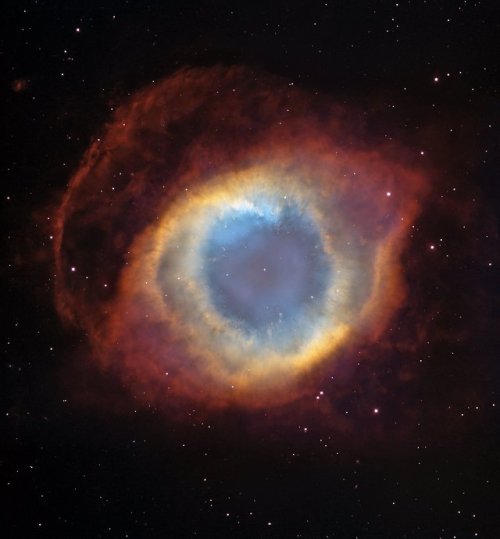
SALLY RIDE, FIRST AMERICAN WOMAN IN SPACE, DISCUSSES BEING AN ASTRONAUT WITH GLORIA STEINEM
https://rocket-women.com/2016/02/sally-ride-first-american-woman-in-space-discusses-being-an-astronaut-with-gloria-steinem/
“Eye of God”
About this image
This composite image is a view of the colorful Helix Nebula taken with the Advanced Camera for Surveys aboard NASA's Hubble Space Telescope and the Mosaic II Camera on the 4-meter telescope at Cerro Tololo Inter-American Observatory in Chile. The object is so large that both telescopes were needed to capture a complete view. The Helix is a planetary nebula, the glowing gaseous envelope expelled by a dying, sun-like star. The Helix resembles a simple doughnut as seen from Earth. But looks can be deceiving. New evidence suggests that the Helix consists of two gaseous disks nearly perpendicular to each other.
One possible scenario for the Helix's complex structure is that the dying star has a companion star. One disk may be perpendicular to the dying star's spin axis, while the other may lie in the orbital plane of the two stars. The Helix, located 690 light-years away, is one of the closest planetary nebulas to Earth.
The Hubble images were taken on November 19, 2002; the Cerro Tololo images on Sept. 17-18, 2003.
In 2011, a report from a National Academy of Sciences’ decadal survey emphasized the need to examine and understand the influences that sex and gender have on physiological and psychological or behavioral changes that occur during spaceflight. In response, NASA and NSBRI assembled six workgroups to investigate and summarize the current body of published and unpublished human and animal spaceflight research data. The groups focused on cardiovascular, immunological, sensorimotor, musculoskeletal, reproductive and behavioral implications on spaceflight adaptation for men and women.
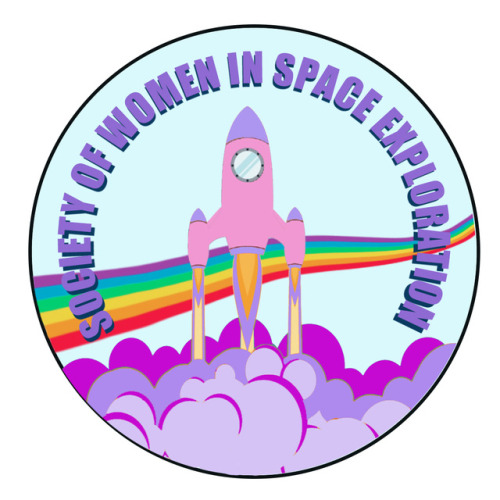
Society of Women in Space Exploration
https://www.swise.org
Interview with Bianca Vasquez - Founder
1. Can you share a bit about yourself and what you do?
I am a mechanical engineering student at Santa Barbara City College. I will be transferring to university within the next year or two. When I'm not doing school related work, I run the Society of Women in Space Exploration, an organization that provides a platform for young girls in college to learn more about themselves as young professionals and future leaders and allow for them to take on a leadership role in their community.
2. What made you interested in space/space exploration?
Like most people interested in space, the curiosity. There are so many questions that come with space that we have about the past, the present, and the future of our universe. What really got me excited about pursuing it, was learning about many of the incredible women that contribute to the discoveries and innovation and how although they are a minority in the field, they own it and continue to thrive and be examples for other young girls that wish to follow in their footsteps! Representation matters and having role models can really affect the way you feel about your goals.
3. What are some challenges you’ve had to face within this field?
I've dealt a lot with imposter syndrome. Space exploration, and STEM in general, is highly competitive. When you do not grow up with the resources and the representation, you start to doubt your abilities. For a few years in college I was in and out of pursuing STEM because I didn't know if I belonged. The truth is, anyone that wants to do this belongs. We need to give more girls and minorities the confidence to follow their dreams, and when more of us do, we open doors for others after us. We wonder why so many women drop out of STEM in general.. it's not because they don't like it, it's because things can be hard when you feel isolated and underrepresented. I've found that I do better when I am around people that are inclusive, welcoming, encouraging, and resemble me somehow. Whether that's other Latinos, other women, or just like minded people.
4. What do you hope to achieve with your society?
I truly hope Society of Women in Space Exploration (SWISE) encourages other girls to pursue their space dreams. I want SWISE to bring girls with similar ambitions together and develop lifelong friendships and genuine bonds + support systems. We do better when we uplift each other and support each other. I hope SWISE positively affects these girls and changes the way they feel about being a minority in the industry; by seeing it as a strength rather than a setback.
5. Some of your inspirations and why?
I do not have a specific dream job (yet) because there are so many things out there, and I am constantly growing and learning more about myself, but I do know that I want to be happy with what I end up doing, and work with positive, innovative people that want to change the world for the better. To work on things that will be sent to space to further our knowledge on the universe would be awesome!!
6. Anything else you’d like to share? (personal experiences/ advice for other women)
Diversity is so so so important. When we have a diverse group of people working to fix a problem, we hear things from different perspectives. We operate with so much context- our backgrounds, our experiences, our way of doing things. Diversity in thought = diversity in solutions. That goes for any field. Diversity in space exploration is extremely key because space is the biggest thing out there. It's not man made, and we can't control it. We can only understand it, and in order to do so, we need all the greatest, most innovative and curious minds we can get!
Tampons were packed with their strings connecting them, like a strip of sausages, so they wouldn’t float away. Engineers asked Ride, “Is 100 the right number?” She would be in space for a week. “That would not be the right number,” she told them. At every turn, her difference was made clear to her. When it was announced Ride had been named to a space flight mission, her shuttle commander, Bob Crippen, who became a lifelong friend and colleague, introduced her as “undoubtedly the prettiest member of the crew.” At another press event, a reporter asked Ride how she would react to a problem on the shuttle: “Do you weep?”
Astronaut Sally Ride and the Burden of Being “The First” (via dinosaurparty)
Facts About Women in Space Exploration
1. In 1963 Valentina Tereshkova became the first woman sent to space, just two years after her male counterpart Yuri Gagarin. (only 12 other men had been to space at the time) article
2. Women make up less than 11 percent of history’s space explorers.
3. 538 total space travelers, 62 have been women.
4. A span of 19 years separated the first and second women in space.

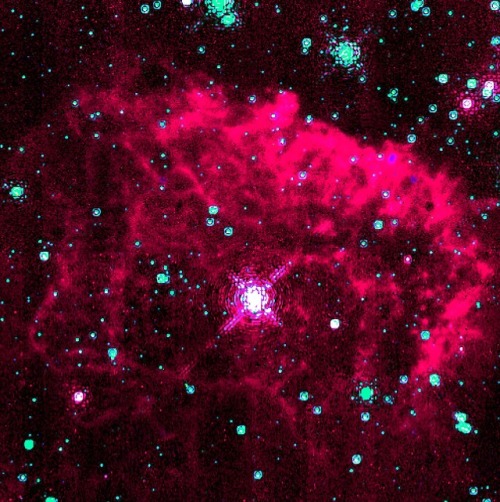
Marsha Ivins on board the space shuttle Atlantis in 2001
Mission Specialist (MS) Marsha Ivins, her hair loose and free floating in microgravity, smiles for the camera on Atlantis' Aft Flight Deck (AFD). Photo was taken during Mission STS-98 International Space Station (ISS) Flight 5A.
Identifier sts098-348-015
From here
The Pistol Nebula
Want to see the brightest star in the sky? It would seem that on October 8, 1997, the Hubble Space Telescope found the most luminous star in the midst of a bright nebula. The star in question emits far more power than our Sun does – and its diameter alone encompasses the Earth’s entire orbit around the Sun. Though it certainly doesn’t seem quite as large in the beautiful, violet-hued image.
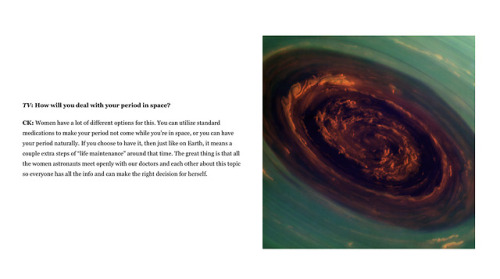
Interview With Astronaut Christina Koch
https://www.teenvogue.com/story/interview-with-astronaut-christina-koch
The Rose
The spinning vortex of Saturn north polar storm resembles a deep red rose of giant proportions surrounded by green foliage in this false-color image from NASA Cassini spacecraft.
“Menstruation is not an issue in space travel. Gravity is not essential for menstruation to occur. Menstruation is a very complicated physiological process involving the internal factors of many different hormones, the woman's sexual organs, and the brain.” - Dr Stephen Juan
Read more
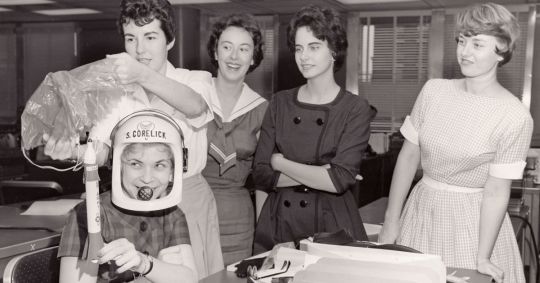

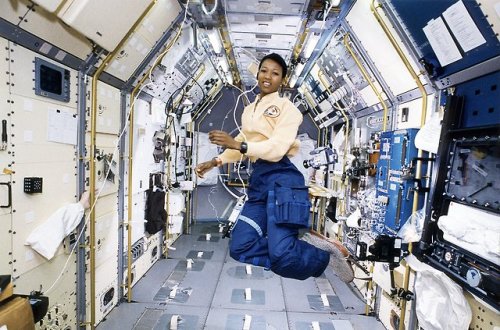
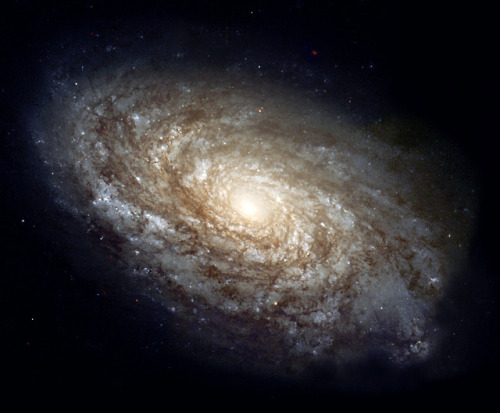
Astronaut Mae Jemison Working in Spacelab-J
Description (October 22, 1992) Space Shuttle Endeavour (STS-47) onboard photo of Astronaut Mae Jemison working in Spacelab-J module. Spacelab-J is a combined National Space Development Agency of Japan (NASDA) and NASA mission. The objectives included life sciences, microgravity and technology research.
Identifier: MSFC-9265609
Magnificant Details in a Dusty Spiral Galaxy
(June 3, 1999) In 1995, the majestic spiral galaxy NGC 4414 was imaged by the Hubble Space Telescope as part of the HST Key Project on the Extragalactic Distance Scale. An international team of astronomers, led by Dr. Wendy Freedman of the Observatories of the Carnegie Institution of Washington, observed this galaxy on 13 different occasions over the course of two months. Images were obtained with Hubble's Wide Field Planetary Camera 2 (WFPC2) through three different color filters. Based on their discovery and careful brightness measurements of variable stars in NGC 4414, the Key Project astronomers were able to make an accurate determination of the distance to the galaxy. The resulting distance to NGC 4414, 19.1 megaparsecs or about 60 million light-years, along with similarly determined distances to other nearby galaxies, contributes to astronomers' overall knowledge of the rate of expansion of the universe. In 1999, the Hubble Heritage Team revisited NGC 4414 and completed its portrait by observing the other half with the same filters as were used in 1995. The end result is a stunning full-color look at the entire dusty spiral galaxy. The new Hubble picture shows that the central regions of this galaxy, as is typical of most spirals, contain primarily older, yellow and red stars. The outer spiral arms are considerably bluer due to ongoing formation of young, blue stars, the brightest of which can be seen individually at the high resolution provided by the Hubble camera. The arms are also very rich in clouds of interstellar dust, seen as dark patches and streaks silhouetted against the starlight.
Image # : PR99-25
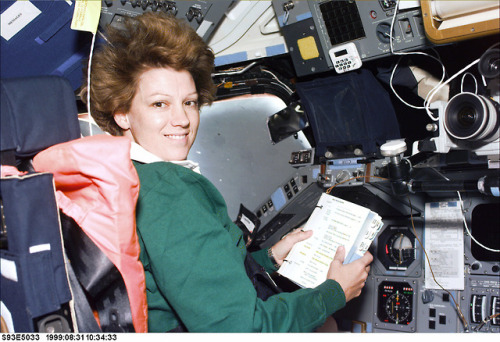
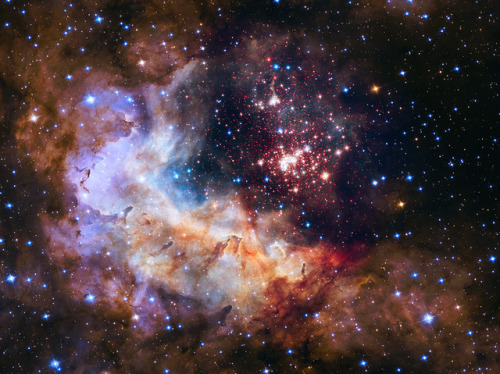
Columbia Commander Eileen Collins
(July 24, 1999) Commander Eileen Collins consults a checklist while seated at the flight deck Commander's station in the Shuttle Columbia during STS-93.
Image # : S93E5033
Hubble Space Telescope Celebrates 25 Years of Unveiling the Universe
The brilliant tapestry of young stars flaring to life resemble a glittering fireworks display in the 25th anniversary NASA Hubble Space Telescope image to commemorate a quarter century of exploring the solar system and beyond since its launch on April 24, 1990.
The sparkling centerpiece of Hubble's silver anniversary fireworks is a giant cluster of about 3,000 stars called Westerlund 2, named for Swedish astronomer Bengt Westerlund, who discovered the grouping in the 1960s. The cluster resides in a raucous stellar breeding ground known as Gum 29, located 20,000 light-years away from Earth in the constellation Carina.


Kathryn Sullivan
Astronaut Kathryn D. Sullivan, 41-G mission specialist, uses binoculars for a magnified viewing of earth through the forward cabin windows.
Image #: 41G-11-027
Date: October 6, 1984
Hubble's Sharpest View of the Orion Nebula
This dramatic image offers a peek inside a cavern of roiling dust and gas where thousands of stars are forming. The image, taken by the Advanced Camera for Surveys (ACS) aboard NASA's Hubble Space Telescope, represents the sharpest view ever taken of this region, called the Orion Nebula. More than 3,000 stars of various sizes appear in this image. Some of them have never been seen in visible light. These stars reside in a dramatic dust-and-gas landscape of plateaus, mountains, and valleys that are reminiscent of the Grand Canyon. The Orion Nebula is a picture book of star formation, from the massive, young stars that are shaping the nebula to the pillars of dense gas that may be the homes of budding stars. The bright central region is the home of the four heftiest stars in the nebula. The stars are called the Trapezium because they are arranged in a trapezoid pattern. Ultraviolet light unleashed by these stars is carving a cavity in the nebula and disrupting the growth of hundreds of smaller stars. Located near the Trapezium stars are stars still young enough to have disks of material encircling them. These disks are called protoplanetary disks or "proplyds" and are too small to see clearly in this image. The disks are the building blocks of solar systems. The bright glow at upper left is from M43, a small region being shaped by a massive, young star's ultraviolet light. Astronomers call the region a miniature Orion Nebula because only one star is sculpting the landscape. The Orion Nebula has four such stars. Next to M43 are dense, dark pillars of dust and gas that point toward the Trapezium. These pillars are resisting erosion from the Trapezium's intense ultraviolet light. The glowing region on the right reveals arcs and bubbles formed when stellar winds - streams of charged particles ejected from the Trapezium stars - collide with material. The faint red stars near the bottom are the myriad brown dwarfs that Hubble spied for the first time in the nebula in visible light. Sometimes called "failed stars," brown dwarfs are cool objects that are too small to be ordinary stars because they cannot sustain nuclear fusion in their cores the way our Sun does. The dark red column, below, left, shows an illuminated edge of the cavity wall. The Orion Nebula is 1,500 light-years away, the nearest star-forming region to Earth. Astronomers used 520 Hubble images, taken in five colors, to make this picture. They also added ground-based photos to fill out the nebula. The ACS mosaic covers approximately the apparent angular size of the full moon. The Orion observations were taken between 2004 and 2005.


Sullivan and Ride Show Sleep Restraints
Description: Astronauts Kathryn D. Sullivan, left, and Sally K. Ride display a "bag of worms." The "bag" is a sleep restraint and the majority of the "worms" are springs and clips used with the sleep restraint in its normal application. Clamps, a bungee cord and velcro strips are other recognizable items in the bag.
Image # : 41G-07-021
Date: October 6, 1984
NASA Hubble Sees Sparring Antennae Galaxies The NASA/ESA Hubble Space Telescope has snapped the best ever image of the Antennae Galaxies. Hubble has released images of these stunning galaxies twice before, once using observations from its Wide Field and Planetary Camera 2 (WFPC2) in 1997, and again in 2006 from the Advanced Camera for Surveys (ACS). Each of Hubble’s images of the Antennae Galaxies has been better than the last, due to upgrades made during the famous servicing missions, the last of which took place in 2009.
The galaxies — also known as NGC 4038 and NGC 4039 — are locked in a deadly embrace. Once normal, sedate spiral galaxies like the Milky Way, the pair have spent the past few hundred million years sparring with one another. This clash is so violent that stars have been ripped from their host galaxies to form a streaming arc between the two. In wide-field images of the pair the reason for their name becomes clear — far-flung stars and streamers of gas stretch out into space, creating long tidal tails reminiscent of antennae.
This new image of the Antennae Galaxies shows obvious signs of chaos. Clouds of gas are seen in bright pink and red, surrounding the bright flashes of blue star-forming regions — some of which are partially obscured by dark patches of dust. The rate of star formation is so high that the Antennae Galaxies are said to be in a state of starburst, a period in which all of the gas within the galaxies is being used to form stars. This cannot last forever and neither can the separate galaxies; eventually the nuclei will coalesce, and the galaxies will begin their retirement together as one large elliptical galaxy.
This image uses visible and near-infrared observations from Hubble’s Wide Field Camera 3 (WFC3), along with some of the previously-released observations from Hubble’s Advanced Camera for Surveys (ACS).
Image Credit: Hubble/European Space Agency
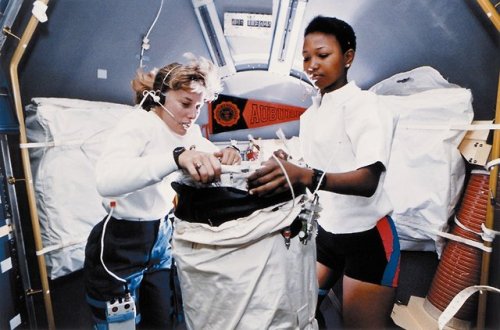
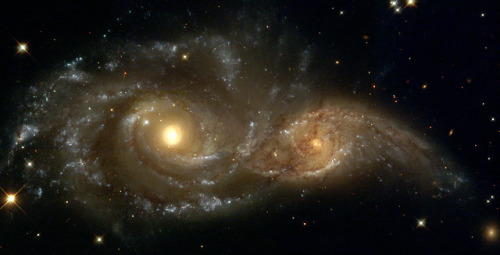
Astronauts Jan Davis & Mae Jemison on STS-47
Astronauts Dr. N. Jan Davis (left) and Dr. Mae C. Jemison (right) were mission specialists on board the STS-47 mission. The astronauts are shown preparing to deploy the lower body negative pressure (LBNP) apparatus in this 35mm frame taken in the science module aboard the Earth-orbiting Space Shuttle Endeavor.
Image # : 92-HC-641
Date: August 15, 1992
A Grazing Encounter Between Two Spiral Galaxies
The larger and more massive galaxy is cataloged as NGC 2207 (on the left in the Hubble Heritage image), and the smaller one on the right is IC 2163. Strong tidal forces from NGC 2207 have distorted the shape of IC 2163, flinging out stars and gas into long streamers stretching out a hundred thousand light-years toward the right-hand edge of the image. Computer simulations, carried out by a team led by Bruce and Debra Elmegreen, demonstrate the leisurely timescale over which galactic collisions occur. In addition to the Hubble images, measurements made with the National Science Foundation's Very Large Array Radio Telescope in New Mexico reveal the motions of the galaxies and aid the reconstruction of the collision.
Image # : PR99-41
Date: November 4, 1999